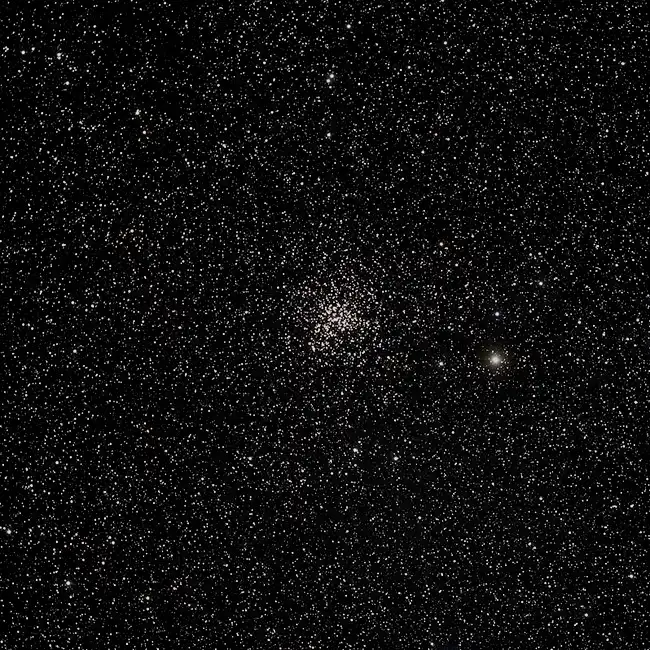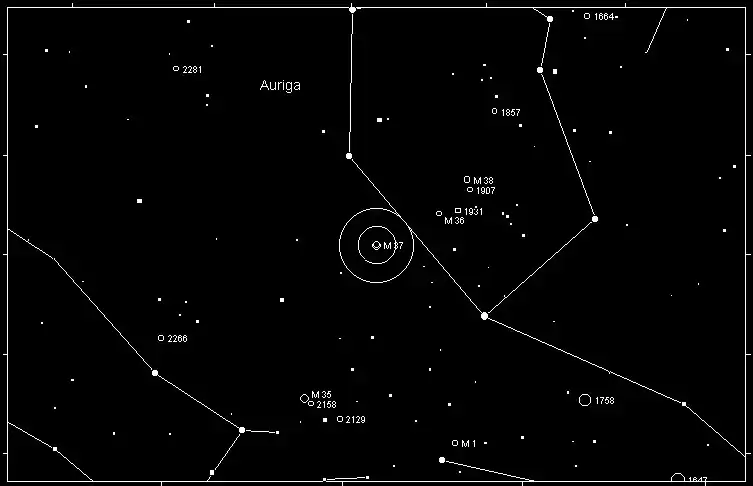Messier 37 (M37), also known as NGC 2099, is a rich open star cluster located in the constellation Auriga. It is the brightest and most populated of the three Messier star clusters in Auriga, making it a fascinating object for amateur astronomers and seasoned stargazers alike. This cluster is a spectacular sight through telescopes of all sizes and is especially notable for its dense population of stars.
Description and Magnitude
Messier 37 is a dense open cluster containing over 500 stars, with around 150 of them being brighter than magnitude 12. It has an apparent magnitude of 6.2, making it visible under dark skies with the naked eye, though it is best observed through binoculars or a small telescope to appreciate its full beauty. The cluster spans about 24 arcminutes across, roughly equivalent to the size of the full moon, and is located approximately 4,500 light-years away from Earth.
M37 is characterized by a mix of bright and faint stars, with a noticeable red giant star near its center, adding a touch of color to the otherwise bluish-white cluster. The overall appearance is that of a rich, well-populated cluster with stars densely packed towards the center and gradually thinning out towards the edges.

Prominence and Observing Season
Messier 37 is best observed during the winter months in the Northern Hemisphere when the constellation Auriga is prominently placed in the night sky. It reaches its highest point in the sky around January, making it an ideal target for winter stargazing. Observers in the Southern Hemisphere will find it more challenging to observe, as Auriga doesn't rise very high above the horizon.
Location and Constellation
M37 is situated within the constellation Auriga, also known as the Charioteer. Auriga is a large and easily recognizable constellation, shaped somewhat like a pentagon. The brightest star in Auriga is Capella, a brilliant golden star that is one of the brightest in the night sky.
Finding Messier 37
To locate M37, start by finding the constellation Auriga, which is most easily identified by its brightest star, Capella. Once you've located Capella, look slightly to the southeast to find three clusters: M36, M37, and M38, which form a triangle. M37 is the easternmost cluster of the three.
Using a low-power telescope or binoculars, sweep the area southeast of Capella. M37 will appear as a fuzzy patch of light. When viewed through a medium-sized telescope, the cluster resolves into a stunning collection of stars, with its dense core and the prominent red giant at its center becoming more apparent.

History
Messier 37 was discovered by Italian astronomer Giovanni Battista Hodierna before 1654, though it was independently rediscovered by Charles Messier in 1764, who then included it in his famous catalog of deep-sky objects. Messier's catalog was originally compiled to help comet hunters avoid mistaking these stationary objects for comets.
Over the centuries, Messier 37 has been studied extensively, with astronomers noting its richness and the variety of stars it contains. It is considered one of the finest open clusters visible from Earth, often cited as a prime example of the beauty and complexity of such clusters.
Conclusion
Messier 37 is a brilliant and dense open star cluster that captivates observers with its richness and vibrant stars. Located in the constellation Auriga, it is best viewed during the winter months in the Northern Hemisphere. Whether viewed through binoculars or a telescope, M37 offers a mesmerizing glimpse into the night sky's stellar gatherings, making it a must-see object for astronomy enthusiasts. Its historical significance and visual appeal ensure that Messier 37 remains a favorite target for stargazers worldwide.
